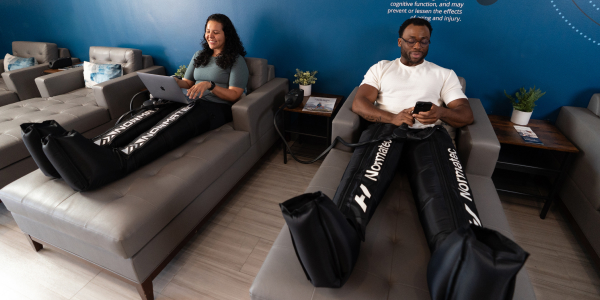Runners are always looking for ways to improve their performance, whether it's through training techniques, nutrition, or recovery methods. One of the latest advancements helping athletes enhance their endurance is Mild Hyperbaric Oxygen Therapy (mHbOT). While the therapy is often used for injury recovery, recent research indicates that mHbOT can also improve aerobic activity for runners by optimizing oxygen uptake, boosting energy production, and enhancing overall cardiovascular function.
What is Mild Hyperbaric Oxygen Therapy?
Mild Hyperbaric Oxygen Therapy involves breathing concentrated oxygen in a pressurized chamber. Unlike traditional Hyperbaric Oxygen Therapy, which exposes individuals to higher atmospheric pressures (up to 3 atm), mHbOT operates at a much gentler level, typically around 1.3 atm. The therapy is considered "mild" because it uses lower pressure while still delivering significant oxygen saturation benefits to the body.
The key benefit of mHbOT is its ability to increase the amount of dissolved and bound oxygen in the bloodstream. This heightened oxygen concentration enhances cellular function, improves circulation and accelerates recovery, making it a valuable tool for athletes, especially runners looking to optimize their aerobic capacity.
How Does mHbOT Work?
When a runner undergoes Mild Hyperbaric Oxygen Therapy, they sit inside a pressurized chamber for about 60-90 minutes, breathing enhanced oxygen. The slightly increased pressure combined with higher oxygen levels allows the lungs to absorb more oxygen than they would in a normal environment.
The additional oxygen enters the bloodstream, where it can be transported to tissues throughout the body, including muscles that rely heavily on oxygen during aerobic activity. This process enhances overall oxygen efficiency, enabling athletes to generate energy more effectively during endurance exercises like long-distance running.
The Science Behind mHbOT for Runners
A recent study explored the impact of mHbOT on running performance by analyzing how the therapy affected key physiological markers such as oxygen uptake (VO2), anaerobic threshold (AT), and respiratory compensation point (RCP)—all critical factors that influence performance in endurance sports.
Study Overview
The study involved nine male junior long-distance runners who were exposed to either a normal air environment (1 atm, 20.9% oxygen) or a Mild Hyperbaric Oxygen environment (1.3 atm, 36%–40% oxygen) for 40 minutes at rest. After each session, they underwent a cardiopulmonary exercise test using an ergometer to measure their respiratory and circulatory responses.
Key Findings
The results showed that mHbOT increased oxygen efficiency after the anaerobic threshold (AT) and prolonged the appearance of the respiratory compensation point (RCP).
Here's what that means for runners:
Anaerobic Threshold (AT): This is the point during exercise when the body transitions from aerobic energy production to anaerobic energy production. Improving oxygen efficiency at this point means that runners can perform at higher intensities without quickly exhausting their aerobic capacity, allowing for longer, more efficient running sessions.
Respiratory Compensation Point (RCP): The RCP marks the stage when breathing becomes disproportionately more labored compared to the exercise intensity, a sign that the body is reaching its limit. By delaying the RCP, mHbOT enables runners to perform at peak intensity for longer periods before their bodies begin compensating with more rapid and inefficient breathing.
Implications for Runners
The study suggests that mHbOT improves oxygen utilization and energy generation, particularly during the critical AT-RCP phase of running. Most long-distance running takes place within this range, meaning runners can significantly improve their performance by prolonging the time before they reach RCP. As a result, runners may be able to sustain high-intensity running for longer periods, potentially improving their race times.
Why Runners Should Consider mHbOT
For runners, endurance and aerobic capacity are everything. mHbOT offers a scientifically backed method to enhance both by improving oxygen uptake, prolonging peak performance phases and increasing overall energy efficiency.
Here’s why booking an mHbOT session might be the key to reaching your next running goal:
Improved Oxygen Efficiency:
By increasing oxygen availability in the bloodstream, mHbOT helps muscles work more efficiently, delaying fatigue and enhancing endurance.
Faster Recovery:
The increased oxygen supply also speeds up recovery, reducing inflammation and accelerating muscle repair, making it easier for runners to recover between workouts or competitions.
Enhanced Energy Generation:
The ability to delay the anaerobic threshold and respiratory compensation point means that runners can push harder for longer, leading to improved race performance and personal bests.
Safe and Non-Invasive:
mHbOT is a gentle, non-invasive therapy that supports the body’s natural recovery processes. It’s a safe way for athletes to improve their aerobic performance without the risks associated with more intensive treatments or interventions.
Ready to Boost Your Running Performance?
Whether you're training for a marathon, working to set a personal record, or simply aiming to improve your aerobic capacity, Mild Hyperbaric Oxygen Therapy offers a unique advantage. The science is clear—enhanced oxygen availability through mHbOT can help improve key performance markers like VO2, anaerobic threshold and respiratory compensation point, to help push your limits and achieve new milestones.
Book an appointment to experience how mHbOT can help you reach your peak performance as a runner.
Medical services are provided by an independently-owned physician practice. Some services may require medical clearance and a prescription. We reserve the right to refuse service to anyone. Services, therapies, nutrients and prices may vary per location. The content on our site, blog posts, educational materials, apps, promotional newsletters, and any other written content are not intended to replace an evaluation with a qualified healthcare professional and are not intended as medical advice.






